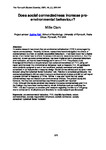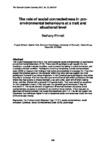The evolutionary and ecological consequences of animal social networks: emerging issues
| dc.contributor.author | Kurvers, RHJM | |
| dc.contributor.author | Krause, J | |
| dc.contributor.author | Croft, DP | |
| dc.contributor.author | Wilson, Alexander | |
| dc.contributor.author | Wolf, M | |
| dc.date.accessioned | 2018-05-09T10:25:59Z | |
| dc.date.issued | 2014-06 | |
| dc.identifier.issn | 0169-5347 | |
| dc.identifier.issn | 1872-8383 | |
| dc.identifier.uri | http://hdl.handle.net/10026.1/11456 | |
| dc.description.abstract |
The first generation of research on animal social networks was primarily aimed at introducing the concept of social networks to the fields of animal behaviour and behavioural ecology. More recently, a diverse body of evidence has shown that social fine structure matters on a broader scale than initially expected, affecting many key ecological and evolutionary processes. Here, we review this development. We discuss the effects of social network structure on evolutionary dynamics (genetic drift, fixation probabilities, and frequency-dependent selection) and social evolution (cooperation and between-individual behavioural differences). We discuss how social network structure can affect important coevolutionary processes (host-pathogen interactions and mutualisms) and population stability. We also discuss the potentially important, but poorly studied, role of social network structure on dispersal and invasion. Throughout, we highlight important areas for future research. | |
| dc.format.extent | 326-335 | |
| dc.format.medium | Print-Electronic | |
| dc.language | en | |
| dc.language.iso | eng | |
| dc.publisher | Elsevier BV | |
| dc.subject | coevolution | |
| dc.subject | dispersal | |
| dc.subject | evolutionary dynamics | |
| dc.subject | invasion | |
| dc.subject | population stability | |
| dc.subject | social evolution | |
| dc.subject | social networks | |
| dc.subject | social structure | |
| dc.subject | Animals | |
| dc.subject | Behavior, Animal | |
| dc.subject | Biological Evolution | |
| dc.subject | Host-Pathogen Interactions | |
| dc.subject | Population Dynamics | |
| dc.subject | Social Behavior | |
| dc.subject | Symbiosis | |
| dc.title | The evolutionary and ecological consequences of animal social networks: emerging issues | |
| dc.type | journal-article | |
| dc.type | Journal Article | |
| dc.type | Research Support, Non-U.S. Gov't | |
| dc.type | Review | |
| plymouth.author-url | https://www.webofscience.com/api/gateway?GWVersion=2&SrcApp=PARTNER_APP&SrcAuth=LinksAMR&KeyUT=WOS:000336873800008&DestLinkType=FullRecord&DestApp=ALL_WOS&UsrCustomerID=11bb513d99f797142bcfeffcc58ea008 | |
| plymouth.issue | 6 | |
| plymouth.volume | 29 | |
| plymouth.publication-status | Published | |
| plymouth.journal | Trends in Ecology & Evolution | |
| dc.identifier.doi | 10.1016/j.tree.2014.04.002 | |
| plymouth.organisational-group | /Plymouth | |
| plymouth.organisational-group | /Plymouth/Faculty of Science and Engineering | |
| plymouth.organisational-group | /Plymouth/Faculty of Science and Engineering/School of Biological and Marine Sciences | |
| plymouth.organisational-group | /Plymouth/REF 2021 Researchers by UoA | |
| plymouth.organisational-group | /Plymouth/REF 2021 Researchers by UoA/UoA07 Earth Systems and Environmental Sciences | |
| plymouth.organisational-group | /Plymouth/Users by role | |
| plymouth.organisational-group | /Plymouth/Users by role/Academics | |
| dc.publisher.place | England | |
| dcterms.dateAccepted | 2014-04-04 | |
| dc.identifier.eissn | 1872-8383 | |
| dc.rights.embargoperiod | Not known | |
| rioxxterms.versionofrecord | 10.1016/j.tree.2014.04.002 | |
| rioxxterms.licenseref.uri | http://www.rioxx.net/licenses/all-rights-reserved | |
| rioxxterms.licenseref.startdate | 2014-06 | |
| rioxxterms.type | Journal Article/Review |




